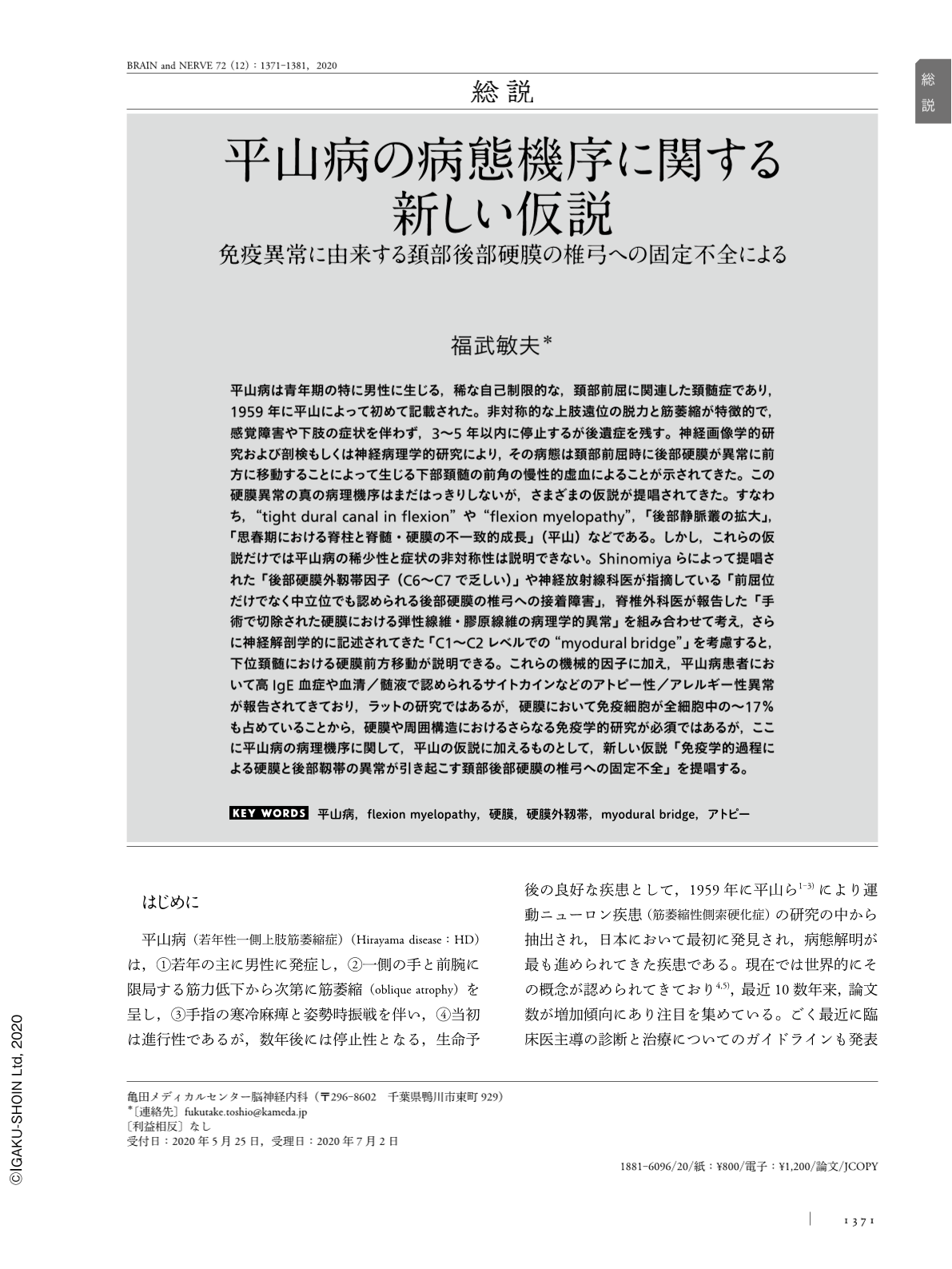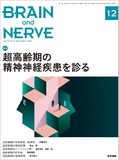Japanese
English
- 有料閲覧
- Abstract 文献概要
- 1ページ目 Look Inside
- 参考文献 Reference
- サイト内被引用 Cited by
平山病は青年期の特に男性に生じる,稀な自己制限的な,頚部前屈に関連した頚髄症であり,1959年に平山によって初めて記載された。非対称的な上肢遠位の脱力と筋萎縮が特徴的で,感覚障害や下肢の症状を伴わず,3〜5年以内に停止するが後遺症を残す。神経画像学的研究および剖検もしくは神経病理学的研究により,その病態は頚部前屈時に後部硬膜が異常に前方に移動することによって生じる下部頚髄の前角の慢性的虚血によることが示されてきた。この硬膜異常の真の病理機序はまだはっきりしないが,さまざまの仮説が提唱されてきた。すなわち,“tight dural canal in flexion”や“flexion myelopathy”,「後部静脈叢の拡大」,「思春期における脊柱と脊髄・硬膜の不一致的成長」(平山)などである。しかし,これらの仮説だけでは平山病の稀少性と症状の非対称性は説明できない。Shinomiyaらによって提唱された「後部硬膜外靱帯因子(C6〜C7で乏しい)」や神経放射線科医が指摘している「前屈位だけでなく中立位でも認められる後部硬膜の椎弓への接着障害」,脊椎外科医が報告した「手術で切除された硬膜における弾性線維・膠原線維の病理学的異常」を組み合わせて考え,さらに神経解剖学的に記述されてきた「C1〜C2レベルでの“myodural bridge”」を考慮すると,下位頚髄における硬膜前方移動が説明できる。これらの機械的因子に加え,平山病患者において高IgE血症や血清/髄液で認められるサイトカインなどのアトピー性/アレルギー性異常が報告されてきており,ラットの研究ではあるが,硬膜において免疫細胞が全細胞中の〜17%も占めていることから,硬膜や周囲構造におけるさらなる免疫学的研究が必須ではあるが,ここに平山病の病理機序に関して,平山の仮説に加えるものとして,新しい仮説「免疫学的過程による硬膜と後部靱帯の異常が引き起こす頚部後部硬膜の椎弓への固定不全」を提唱する。
Abstract
Hirayama disease is a rare and self-limiting cervical myelopathy related to neck flexion in adolescents, predominantly male, originally described by Hirayama in 1959 and until today reported worldwide. It characteristically presents with asymmetric distal upper extremity muscular weakness and atrophy without objective sensory disturbance or lower extremity involvement, which spontaneously halts within 3-5 years after onset with some sequelae. Neuroradiological and autopsy/neuropathological studies have shown that the condition is caused by chronic ischemic changes to the anterior horn cells of the lower cervical cord due to abnormal forward-shifting of the lower cervical posterior dura on neck flexion. Although the true pathomechanism of the dural changes is still unknown, various hypothetical theories have been formulated: “tight dural canal in flexion”, “flexion myelopathy”, “engorgement of the posterior venous plexus”, and “disproportional growth between the vertebral column and the contents of the spinal canal during puberty” (Hirayama). However, rarity of the condition and asymmetric cord involvement cannot be explained with these theories alone. Combination of a “posterior epidural ligament [sparse at C6-C7] factor” proposed by Shinomiya , “loss of dorsal dural attachment from the pedicle even in neutral position in the MRI” pointed out by some neuroradilogists, and “pathological abnormalities of elastic and collagen fibers in the operatively-resected dura” reported by several spinal surgeons suggest that abnormal changes of the dura and posterior ligaments, as well as the existence of “myodural bridge” at C1-C2 described by some neuroanatomists, can cause the dural forward-shifting of the lower cervical cord. In addition to these mechanical factors, immunological abnormalities such as hyperIgEemia and upreguration of some cytokines and chemokines in serum/CSF of patients with Hirayama disease have been reported. Furthermore, immune cells comprise 〜17% of all cells in the dura in rats. In conclusion, although further immunological studies of the patient's cervical dura and surrounding structures are required, I propose, in addition to Hirayama's theory, a new hypothesis about the pathomechanism of Hirayama disease, “loss of dorsal dural attachment from the pedicle due to immunological abnormalities of the dura and posterior ligaments”, which can resolve the remaining problems of the condition.
(Received May 25, 2020; Accepted July 2, 2020; Published December 1, 2020)

Copyright © 2020, Igaku-Shoin Ltd. All rights reserved.


